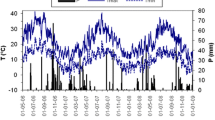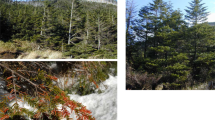Summary
The diurnal course of the xylem water flow in a solitary Salix fragilis L. tree in a wet grassland was measured using the tissue heat-balance method. There was considerable variation due to meteorological factors. Maximum flow rate was 0.4 kg h-1 m-2 of crown projection area, or 5.9 kg h-1 kg-1 leaf dry weight. The daily total was 2.4 kg m-2 day-1 or 36 kg kg-1 day-1. Water flow decreased immediately at the tree base and at the branches after start of rain, and in a branch, after cutting it off: the time constant of the system was 600–700 s in both cases. The part of the crown oriented to the sun transpired up to ten times as much as the shaded part. Over 70% of the total cross-sectional area of the conductive xylem vessels of the trunk was used by the transpiration flow. The water content of the trunk tracked the diurnal changes of the xylem water flow rate with a short time-lag. During the day, 1% of the trunk volume was temporarily exploited as water reserve, an amount equalling 3% of daily water loss. The stereometric configuration of the crown significantly influenced its water loss. During the summer period, about 33 mature (polycormic) trees per ha may drain 100% of water consumed by the present-day sedge-grass marsh.
Similar content being viewed by others
References
Arcikhovskiy VM (1931) Vsasyvanije vody děrevjami pri iskusstvennom vveděnii jejo čerez otvěrstvija vodonosnoj tkani. Trudy po lesnomu opytnomu dělu, CLOS, LL. 69-141
Balabán K (1955) Anatomie dřeva [Wood anatomy]. Praha: SZN 1955, p 210
Čermák J, Deml M, Penka M (1973) A new method of sap flow rate determination in trees. Biol Plant 15: 171–178
Čermák J, Kučera J (1981) The compensation of natural temperature gradient in the measuring point during the sap flow rate determination in trees. Biol Plant 23: 469–471
Čermák J, Kučera J, Penka M (1976) Improvement of the method of sap flow rate determination in adult trees based on heat balance with direct electric heating of xylem. Biol Plant 18: 105–110
Čermák J, Úlehla J, Kučera J, Penka M, (1982) Sap flow rate and transpiration dynamics in the full-grown oak (Quercus robur L.) in floodplain forest exposed to seasonal floods as related to potential evapotranspiration and tree dimensions. Biol Plant 24: 446–460
Čermák J, Kučera J, Simon J, Dušek V (1983) The electric conductance of seedling stems and the water content of spruce and pine in the course of desiccation. Biol Plant 25: 468–471
Cowan IR, Milthorpe FL (1968) Plant factors influencing the water status of plant tissues. In: Kozlowski TT (ed) Water deficits and plant growth. Academic Press, New York London. Vol 1, pp 137–193
Daum CR (1967) A method for determining water transport in trees. Ecology 48: 425–431
Davies WJ, Kozlowski TT (1974) Stomatal responses of five woody angiosperms to light intensity and humidity. Can J Bot 52: 1525–1534
Greenidge KNH (1958) A note on the rates of upward travel of moisture under differing experimental conditions. Can J Bot 36: 357–361
Heine RW (1970) Estimation of conductivity and conducting area of Poplar stems using a radioactive tracer. Annals of Botany 34: 1019–1024
Heine RW (1971) Hydraulic conductivity in trees. J Exp Bot 22: 503–511
Huber B (1932) Beobachtungen und Messungen pflanzlicher Saftströme. Ber dtsch bot Ges 50: 89–109
Huber B (1956) Die Gefäßleitung. In: Stocker O (ed) Pflanzen und Wasser. Handbuch f Pflanzenphysiol Vol III, 541–582
Huber B, Schmidt E (1936) Weitere thermoelektrische Untersuchungen über den Transpirationsstrom der Bäume. Tharandter Forstliches Jahrbuch 87: 369–412
Jarvis PG (1981) Plant water relations in models of tree growth. Studia Forestalia Suecica Nr 160, 51–60
Jeník J, Květ J (eds) (1983) Zaplavované ekosystémy u Třeboně [Flooded ecosystems near Třeboň]. Studie ČSAV, Praha 4: 1–147
Kreeb K (1966) Die Registrierung des Wasserzustandes über die elektrische Leitfähigkeit der Blätter. Ber dtsch bot Ges 79: 150–162
Kučera J, Čermák J, Penka M (1977) Improved thermal method of continual recording the transpiration flow dynamics. Biol Plant 19: 413–420
Landsberg JJ, Blanchard TW, Warrit B (1976) Studies on the movement of water through apple trees. J Exp Bot 27: 579–596
Larcher W (1980) Ökologie der Pflanzen. Verlag Eugen Ulmer Stuttgart, p 400
Limberger GE (1974) (Method of observing water flow in trees). Soviet Patent No. 407548
Linacre E (1976) Swamps. In: Vegetation and the atmosphere, Vol 2 Monteith JL (ed) Academic Press, London New York San Francisco, pp 329–347
MacDougal DT (1925) Reversible variations in volume, pressure and movements of sap in trees. Washington: Carnegie Inst of Washington, p 90
Mäde A (1975) Zur Berechnung der potentiellen Evapotranspiration nach Turc. Zeitschrift für Meteorologie, 25/1; 21–24
McNaughton KG, Jarvis PG (1983) Predicting effects of vegetation changes on transpiration and evaporation. In: Water deficits and plant growth. Academic Press, Inc. Vol VII: pp 1–47
Monteith JL (1975) Principles of environmental physics. Edward Arnold, London, p 240
Owston PW, Smith JL, Halverston HG (1972) Seasonal water movement in tree stems. Forest Science 18: 266–272
Přibáň K, Ondok JP (1980) The daily and seasonal course of evapotranspiration from a central Europaean sedge-grass marsh. J Ecol 68: 547–559
Přibáň K, Ondok JP (1984) Heat-balance component and evapotranspiration from a sedge-grass marsh. Folia geobot phytotax (in press)
Rychnovská M, Čermák J, Šmíd P (1980) Water output in a stand of Phragmites communis Trin. A comparison of three methods. Acta Sci Nat Brno 14 (2), 1–27
Sinyukhin AM, Rutkovskii IV, Calkovič MS, Sokolova ES (1967) Koefficient poljarizacii kletok kak pokazatěl žizněsposobnosti drevěsnych rastenij. Elektronnaya obrabotka materialov 2(14): 75–86
Tattar TA, Blanchard RO (1976) Electrophysiological research in plant pathology. Annual Review of Phytopathology 14: 309–325
Author information
Authors and Affiliations
Rights and permissions
About this article
Cite this article
Čermák, J., Jeník, J., Kučera, J. et al. Xylem water flow in a crack willow tree (Salix fragilis L.) in relation to diurnal changes of environment. Oecologia 64, 145–151 (1984). https://doi.org/10.1007/BF00376862
Received:
Issue Date:
DOI: https://doi.org/10.1007/BF00376862




